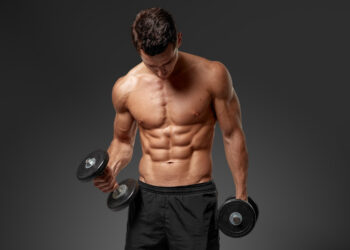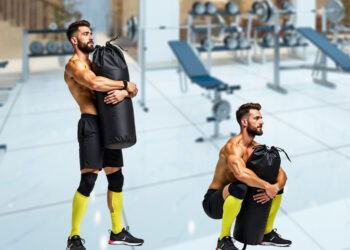Jumping has been part of my workouts for almost as long as I can remember. As a young athlete, my coaches prescribed jumps to improve my sprinting speed. Years later, the physical training instructors in the Royal Marines used jumps to develop my lower body endurance and increase my resistance to injuries.
Even now, despite being in my mid-50s, many of my workouts still involve jumps. Studies and my own experience have shown that jump training is a great way to build and preserve lower-body muscle size, strength, and power (1). Jumps also enhance athleticism and functionality.
There are many different jumping exercises to choose from, including box jumps, hurdle jumps, and depth jumps. However, after many years of trial and error, I’ve found that dumbbell squat jumps to be the most accessible and practical option for most people.
In this article, I reveal how and why to do dumbbell squat jumps and share my top tips and favorite variations for you to try.
How to DO Dumbbell Squat Jump with Correct Form
There are two ways to do most exercises – the right way and the wrong way. The right way is safe and effective, providing the greatest benefits for the lowest risk. The wrong way is usually less effective and more likely to hurt you. To that end, follow these step-by-step instructions to get the most from squat jumps while staying as safe as possible.
- Hold a dumbbell in each hand, arms by your sides, and palms facing inward.
- Pull your shoulders down and back, and brace your core.
- Stand with your feet between hip and shoulder-width apart, knees slightly bent.
- Descend into a squat so your thighs are roughly parallel to the floor.
- Rapidly extend your hips, knees, and ankles, and leap straight into the air as high as possible. Keep your arms straight.
- Land on the balls of your feet with bent legs to absorb the shock of landing.
- Quickly descend into another rep and repeat.
Pro-Trainer Tips
Level Up Your Fitness: Join our 💪 strong community in Fitness Volt Newsletter. Get daily inspiration, expert-backed workouts, nutrition tips, the latest in strength sports, and the support you need to reach your goals. Subscribe for free!
Get more from dumbbell squat jumps with these tried-and-tested pro-trainer tips.
- Descend quickly into each rep to maximize the stretch-shortening reflex (SSR). This increases muscle contractility and force production for a higher jump.
- Land on slightly bent knees to absorb the impact and reduce your risk of injury.
- Keep your upper body and core tight to stabilize the weights and prevent unwanted movement in your spine.
- Strive for a full triple extension in each rep. In other words, drive through your ankles, knees, and hips to maximize jump height and muscle recruitment.
- Only attempt this exercise if you are a proficient squatter. If your regular squat form still needs work, you aren’t ready for dumbbell squat jumps.
- Do this exercise on a forgiving surface, such as a gym mat or sprung floor. Alternatively, make sure you’re wearing very shock-absorbing shoes. This will make the impact more tolerable. Avoid doing it on concrete, paving slabs, tarmac, etc.
Dumbbell Squat Jump Mistakes to Avoid
Make dumbbell squat jumps as safe as possible by avoiding these common mistakes.
- Heavy landings – while landing between reps is inevitable, do your best to land as lightly as possible. This reduces the stress on your joints and lowers the risk of injury.
- Using your arms for assistance – keep your arms engaged but stationary during this exercise. Don’t swing the weights to increase momentum. Doing so could cause you to lose balance, leading to uneven landings and possible injuries.
- Rounding your lower back – a squat jump is still a squat. As such, you should avoid rounding your lower back. A rounded lower back is a weak lower back and prone to injury. Keep your core tight and your chest hip throughout.
- Knees caving in/falling out – ensure your knees track over your feet, and don’t fall in or out. Unstable knees are more prone to wear ‘n’ tear and injury.
- Inconsistent squat depth – descend to the same depth for all your reps. Avoid the temptation to shorten your reps as you get more tired.
Dumbbell Squat Jumps: Muscles Worked
Dumbbell squat jumps are a compound exercise involving multiple muscles and joints working together. The primary muscles trained during dumbbell squat jumps are:
- Quadriceps
- Hamstrings
- Gluteus maximus
- Gastrocnemius and soleus
- Abductors
- Adductors
- Core
- Trapezius
- Forearms
Dumbbell Squat Jump Benefits
Not sure if dumbbell squat jumps deserve a place in your workouts? Consider these benefits and then decide.
A more powerful vertical jump
The principle of specificity states that your body gets better at the activities you perform regularly. Therefore, if you want to jump higher, you must include jumping exercises in your workouts.
There are lots of jumping exercises to choose from, and they all offer benefits. But, in terms of practicality and accessibility, dumbbell squat jumps are one of the best options. As well as making you a better jumper, this exercise will increase general lower body power, translating to faster running, harder kicking, stronger lifting, and other athletic endeavors.
More muscular legs
While they’re not a viable replacement for conventional leg training, dumbbell squat jumps could help you build larger, more muscular legs. They primarily target the fast-twitch (type IIb) muscle fibers, which are responsible for most of your muscle size.
Do dumbbell squat jumps before barbell squats, lunges, leg presses, etc., to fire up your muscles for a more productive workout. Alternatively, do them at the end as a punishing finisher.
Increased fitness and fat-burning
Dumbbell squat jumps involve many different muscles, both in your lower and upper body. As such, this exercise uses a lot of energy and, when done for moderate to high reps, also stresses your cardiovascular system.
Consequently, doing dumbbell squat jumps could help improve your cardiovascular fitness and help you get lean. That’s especially true if you do them as part of a high-intensity interval training (HIIT) workout or as a metabolic circuit. They’re an excellent choice for this purpose.
Level Up Your Fitness: Join our 💪 strong community in Fitness Volt Newsletter. Get daily inspiration, expert-backed workouts, nutrition tips, the latest in strength sports, and the support you need to reach your goals. Subscribe for free!
Workout satisfaction and enjoyment
While this is essentially my own point of view, it’s based on over 30 years of feedback from my clients. Despite being intense and challenging, jumping exercises are fun! They provide a welcome change of pace from all those slow, controlled reps that workouts tend to utilize.
Doing something explosive allows you to “let rip,” which is uniquely satisfying. My clients always look forward to the jumping component of their workouts, and so do I.
Dumbbell Squat Jump Programming
Broadly speaking, there are two ways to approach dumbbell squat jumps – quality and quantity.
With the quality approach, the aim is to jump as high as possible. Your set ends when your jumps start losing height. This is the best way to improve power output and jump performance, e.g., for sports. Reps are kept low to minimize fatigue, with 6-10 per set being typical. Rest for 3-4 minutes between sets to maintain maximal jump height.
In contrast, the quantity approach is all about creating as much fatigue as much as possible. This causes a lot of metabolic stress, which triggers improvements in muscular size, endurance, and cardiovascular conditioning. High reps, e.g., 15-20, are the norm, with brief 30 to 90-second rests between sets to create a deep state of fatigue.
Pick the approach that best matches your training goals. In other words, do maximal effort, low-rep sets to increase muscle power and jump performance, or high-rep sub-max efforts to build muscle mass, endurance, and fitness.
Dumbbell Squat Jump Variations
While I love conventional dumbbell squat jumps, like any exercise, they can become boring and less effective if I do them too often. Keep your training fresh and productive with three of my favorite dumbbell squat jump variations.
1. Dumbbell goblet squat jump
Only got one dumbbell or kettlebell but still want to do weighted jumps? No problem! Just hold your weight in front of your chest in the “goblet” position. Not only does this method require a single weight, but it also puts that weight closer to your center of gravity. My clients report that this position feels more natural than holding dumbbells by their sides.
2. Paused dumbbell squat jump
With this variation, you take a few seconds between reps so that you can put maximum effort into each jump. This is a valuable strategy for improving your jump height for sports, e.g., basketball. So, instead of doing six regular reps, you do six sets of one. This essentially turns a standard set of squat jumps into a cluster set.
3. Dumbbell box jump
One of the main drawbacks of dumbbell squat jumps is the impact on landing. While this may be tolerable for some exercisers, it can be a source of pain and injury for others. Unfortunately, what goes up must come down, so landing is unavoidable after a jump.
That said, you can reduce the impact by landing on a raised surface. That way, you can jump up and then step down. Dumbbell box jumps are a favorite with my older clients, who find regular dumbbell squat jumps too impactful for their joints.
Dumbbell Squat Jump Closing Thoughts
The dumbbell squat jump is a challenging, high-impact exercise that you can adapt to suit multiple training goals.
Done for low reps with maximal effort, they’re a great way to build lower body power and improve jumping performance, e.g., for sports. In contrast, done for higher reps with less effort per jump, this exercise will build muscular endurance and size while challenging your cardiovascular system.
That’s not to say dumbbell squat jumps are suitable for everyone. The impact on landing can be problematic for some and could cause new or aggravate old injuries. But, if you are a proficient squatter with no pre-existing lower limb or back injuries, I think you’ll enjoy this fun and rewarding exercise.
References:
- Arntz F, Mkaouer B, Markov A, Schoenfeld BJ, Moran J, Ramirez-Campillo R, Behrens M, Baumert P, Erskine RM, Hauser L, Chaabene H. Effect of Plyometric Jump Training on Skeletal Muscle Hypertrophy in Healthy Individuals: A Systematic Review With Multilevel Meta-Analysis. Front Physiol. 2022 Jun 27;13:888464. doi: 10.3389/fphys.2022.888464. PMID: 35832484; PMCID: PMC9271893.
Featured Image via @bodybuildingcom on YouTube!
Interested in measuring your progress? Check out our strength standards for Goblet Squat, Squat Jump, Squat, and more.








